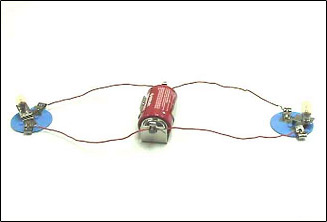Section 5: Lesson Plan
Materials
- "D" cell battery, 2 per pair of students
- Flashlight bulbs, 2 per pair of students
- Bulb holders, 2 per pair of students
- Battery holders, 2 per pair of students
- Wire, (insulated copper wire with plastic coating, apx. 6 inches long with copper ends exposed), 4 per pair of students
- Predictions on Parallel and Series Circuits, 1 per student (PDF 168 KB)
- Investigating Series and Parallel Circuits, 1 per student (PDF 223 KB)
Prep Step
- Review the lesson plan, background information, and understanding goals.
- Gather materials.
- Photocopy Predictions on Parallel and Series Circuits and Investigating Series and Parallel Circuits
Analyze Thinking
Step 1: Revealing Current Models
Ask students to complete the sheets, Predictions on Parallel and Series Circuits. They should try to use what they know about the Cyclic Simultaneous Model and about resistance to help them think about the answers to the questions.
Go over the predictions that students made for each type of configuration. Ask them to explain what they think will happen and why they think it will happen. If any students created models showing what happens at the level of electrons and protons, have them draw them on the board and share them with the group.
Explore Outcomes
Step 2: Exploring What Happens with Series and Parallel Circuits
Give each pair of students the materials and the sheet, Investigating Series and Parallel Circuits.
The sheet asks the students to experiment with series and parallel circuits in which either the batteries or the bulbs are in series or in parallel. The activity sheet is self-explanatory. It's very important that students work step by step, trying each type of circuit, recording their results, and then drawing a model of what they think is going on. To help students with their predictions, make sure that students realize that there is less resistance in the circuit wire (typically made of copper) than in the filament wire. If there is extra time, they can experiment with adding additional batteries and bulbs. If they add too many batteries, they can blow the bulbs because there is too much voltage. This is an interesting finding if you have bulbs to spare.
As students are working, make sure they understand why some circuits are called series circuits and others are called parallel circuits. Circulate and ask students to notice that the bulbs are set up in a series (or line) in a series circuit, while they are parallel to each other in a parallel circuit.
If you notice that students have difficulty understanding what happens with parallel bulbs as they are configured on the sheet (where it looks like one is further from the battery than the other) you can show them a configuration where the battery is in the center with a bulb equidistant on each side. While it is functionally the same as the parallel circuit on the sheet, it is conceptually a smaller leap for students.

Alternate Way of Setting up a Parallel Circuit
Note to Teacher: This lesson does not have an "Explore Causality" step given the length of time needed to explore what happens with series and parallel circuits. The causality steps are part of the next lesson.
Review, Extend, Apply
Step 3: Looking for Examples of Series and Parallel Circuits
Ask students to look for examples of what might be series and parallel circuits around them. They should try to find examples at school and at home to be discussed in the next lesson.


